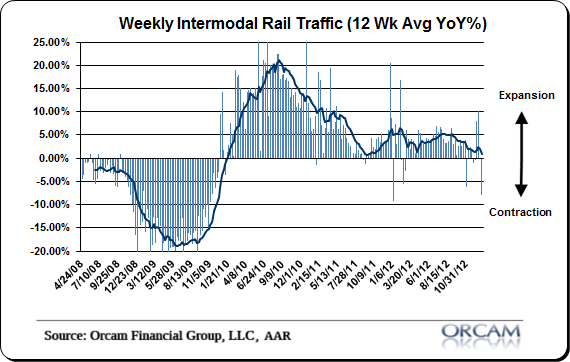The trend in rail traffic has moderated substantially in the last few months as the 12 week moving average in intermodal traffic hit its lowest reading since 2011. The current moving average of 1.34% is consistent with an extremely sluggish economy and one that has come well off the early boom period of the beginning of the recovery when rail traffic was consistently experiencing 10%+ year over year readings.
AAR has more details on this week’s data:
“The Association of American Railroads (AAR) today reported declines in weekly rail traffic for the week ending January 5, 2013, with U.S. railroads originating 241,682 carloads, down 12.1 percent compared with the same week last year. Intermodal volume for the week totaled 178,317 trailers and containers, down 8 percent compared with the same week last year. Traffic volume was likely impacted by the New Year’s holiday, which fell on a Monday and Tuesday in 2013, as opposed to Saturday and Sunday in 2012.
Four of the 20 carload commodity groups posted increases compared with the same week in 2012, with petroleum products, up 53.6 percent; coke, up 12.5 percent, and lumber and wood products, up 6 percent. The groups showing a decrease in weekly traffic included iron and steel scrap, down 29.3 percent; motor vehicles and equipment, down 20.6 percent, and coal, down 19.2 percent.
Weekly carload volume on Eastern railroads was down 12.3 percent compared with the same week last year. In the West, weekly carload volume was down 12 percent compared with the same week in 2012.”
Chart via Orcam Investment Research:
Mr. Roche is the Founder and Chief Investment Officer of Discipline Funds.Discipline Funds is a low fee financial advisory firm with a focus on helping people be more disciplined with their finances.
He is also the author of Pragmatic Capitalism: What Every Investor Needs to Understand About Money and Finance, Understanding the Modern Monetary System and Understanding Modern Portfolio Construction.


Comments are closed.